Introduction to Course Syllabi
Well-structured course syllabi serve as essential tools in educational settings, providing a clear framework for what students can expect throughout a course. They function as roadmaps, outlining course objectives, learning outcomes, evaluation methods, and required materials, which helps set expectations and keeps students focused on their academic goals. A well-defined syllabus also promotes accountability, allowing students to track their progress and understand the standards on which they will be evaluated.
Furthermore, syllabi enhance communication between instructors and students by detailing policies related to attendance, grading, and academic integrity. This transparency fosters a better learning environment where students feel informed and prepared. Research indicates that effective syllabi can improve student engagement and success rates, as they help students take ownership of their learning process through structured guidance [Source: FreightWaves].
In diverse disciplines, a cohesive syllabus can also facilitate interdisciplinary connections, illustrating how different concepts relate within broader academic discussions. This integrative approach can enrich the educational experience and encourage students to explore beyond their immediate coursework [Source: Alachua Chronicle].
Overall, an effective syllabus is not just a list of requirements; it is a strategic instrument that enhances learning by providing structure, clarity, and a pathway to achieving academic success. For further insights, check out related articles on course development and student engagement on our website [Course Description].
Engineering Programs: Crafting Effective Syllabi
An effective engineering course syllabus is pivotal for structuring a comprehensive educational experience. Key components of a robust syllabus include:
- Prerequisites: Clearly defining prerequisites is essential as it sets the baseline for student knowledge and skills. This ensures that learners come prepared, facilitating a cohesive understanding of advanced concepts. When prerequisites are carefully chosen, they can also motivate students to take prior courses seriously [Source: ICDE].
- Course Objectives: Objectives guide both teaching and learning. Well-articulated objectives should be specific, measurable, achievable, relevant, and time-bound (SMART). They help students focus on the expected outcomes and assist instructors in aligning teaching materials and assessment methods with expected competencies [Source: TeachEngineering].
- Methods of Assessment: A diverse range of assessment methods—ranging from examinations and quizzes to projects and peer evaluations—ensures a holistic evaluation of student understanding. It is beneficial to align assessments with course objectives to accurately gauge mastery of the material. Regular feedback through assessments helps students reflect on their knowledge and adapt their learning strategies accordingly [Source: Edutopia].
By incorporating these components thoughtfully, engineering educators can create syllabi that not only foster academic rigor but also enhance student engagement and success. For further exploration on curriculum design, refer to our detailed article on syllabus design best practices.
Science Curriculum: Key Elements of Syllabi
The science curriculum is crucial for engaging students in effective scientific learning. A well-designed syllabus should encompass several key elements:
- Core Topics: A science syllabus should cover fundamental concepts across various disciplines such as biology, chemistry, physics, and earth sciences. This foundational knowledge supports student understanding and promotes interest in the sciences. Critical topics include the scientific method, biodiversity, chemical reactions, energy transfer, and ecological systems, which are essential for fostering a comprehensive understanding of scientific principles [Source: Course Description].
- Laboratory Components: An effective science curriculum incorporates hands-on laboratory experiences. These components allow students to apply theoretical knowledge in practical scenarios, enhancing their critical thinking and problem-solving skills. Experimental activities such as conducting chemical experiments, biological dissections, or physics demonstrations help solidify concepts learned in class and encourage inquiry-based learning [Source: Course Description].
- Interdisciplinary Approaches: Integrating interdisciplinary themes into science education enriches the learning experience and reflects the interconnected nature of scientific knowledge. For example, combining biology with environmental science can address critical issues like climate change, while integrating mathematics can enhance data analysis skills in experimental science. Such approaches foster a holistic understanding and prepare students to think critically about real-world issues [Source: Course Description].
In sum, an effective science curriculum should balance core scientific topics, hands-on laboratory experiences, and interdisciplinary approaches, enabling students to engage deeply with scientific learning and appreciate its relevance to everyday life.
Art Programs: Designing Creative and Structured Syllabi
Designing effective syllabi for art programs necessitates a delicate balance between fostering creativity and providing structured guidelines. Here’s how educators can achieve this through project-based assessments and a thoughtful mix of theoretical and practical components.
- Project-Based Assessments: One of the most effective strategies to encourage creativity is through project-based learning. This approach allows students to collaborate on art projects that integrate various mediums and techniques, providing them with the freedom to explore while adhering to specific guidelines. Projects could range from community art installations to digital media presentations, ensuring that students engage with both the creative process and the technical aspects of art creation. Research indicates that project-based assessments enhance student motivation and retention of knowledge, making them a vital component of art education syllabi [Source: Edutopia].
- Integration of Theory and Practice: Including theoretical elements alongside practical exercises is crucial for a well-rounded art education. Students should study art history, art criticism, and contemporary artistic movements to inform their work and inspire creativity. Assignments might include writing critiques of their work or responding to the works of established artists, thereby blending the analytical with the creative. A structured theoretical framework can enrich students’ artistic voice and technique [Source: Artsy].
- Setting Clear Objectives: While promoting creativity, it’s essential to establish clear learning objectives and grading criteria. Clear guidelines help students focus their creative energies while providing a benchmark for assessment. This structure encourages them to experiment within defined parameters. For example, instructors can set objectives that require students to conceptualize a project around a specific theme, ensuring alignment with broader curricular goals [Source: Course Description].
- Flexibility in Assignments: Allowing flexibility within assignments can also enhance creativity. For instance, rather than prescribing specific materials or techniques, instructors could inspire students to select their preferred mediums for their projects, thereby fostering a sense of ownership and personal expression. This adaptability, paired with structured feedback, supports creative risks [Source: The Art of Education].
By thoughtfully constructing syllabi that interweave creativity with structured assessments, educators can cultivate an enriching learning environment that nurtures both artistic talent and academic rigor.
Resources and Tools for Developing Syllabi
When creating a course syllabus, educators can leverage various resources and tools to enhance engagement and clarity. Here’s a curated list of helpful links and tools:
- Course Description: This platform offers comprehensive descriptions and templates for course syllabi, helping educators clarify objectives, outcomes, and course structure.
- Syllabus Generator by the University of Las Vegas Nevada: This tool allows educators to create customized syllabi more efficiently by providing templates and guidelines for various course elements.
- LinkedIn Learning: Offers a range of courses aimed at best practices for syllabus design, helping educators enhance their teaching strategies.
- Center for Teaching Innovation at Cornell University: This resource provides guidelines and best practices for syllabus development, including tips for inclusive teaching.
- University of Massachusetts Amherst Syllabus Template: A well-structured template equipped with essential sections for course information, assessment methods, and policies.
- Quality Matters: Focused on course design and improvement, this organization provides a rubric for evaluating syllabus effectiveness and alignment with learning objectives.
- Open Educational Resources (OER): Offers a plethora of open-source materials and course content that can be effectively incorporated into syllabi.
These resources not only provide essential frameworks and tools but also enhance the overall quality of syllabus design, ensuring that content is engaging and meets diverse student needs.










